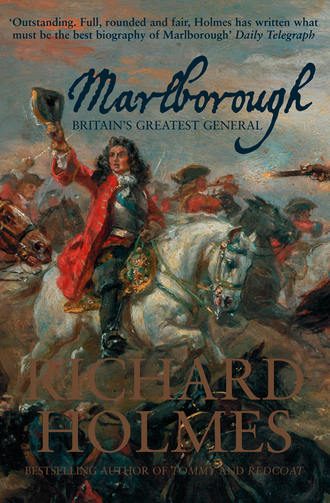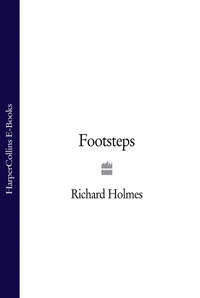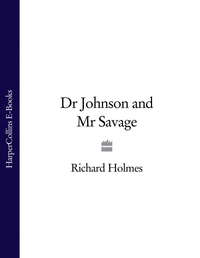
Полная версия
Marlborough: Britain’s Greatest General
In September 1678 he was back in Flanders, this time as a brigadier of foot, his command consisting of two battalions of foot guards, and a battalion each of the Holland, the Duchess’s and Lord Arlington’s regiments. However, he knew that peace negotiations were under way at Nijmegen, and doubted if he would actually get into action. ‘You may rest satisfied that there will be certain peace in a very few days,’ he told Sarah.
The news I do assure you is true; therefore be not concerned when I tell you that I am ordered over and that tomorrow I go. You shall be sure by all opportunities to hear from me, for I do, if possible, love you better than I ever did. I believe it will be about the beginning of October before I shall get back, which time will appear like an age to me, since in all that time I shall not be made happy with the sight of you. Pray write constantly to me. Send your letters as you did before to my house, and there I will take order how they shall be sent off to me. So, dearest soul of my life, farewell.
My duty to my father and mother and remember me to everybody else. Tuesday night. My will I have here sent you for fear of accident.
Sarah later endorsed the letter: ‘Lord Marlborough to ease me when I might be frightened at his going into danger.’13 Her sister’s husband, George Hamilton, had been killed in action, and she knew that status was no guarantor of safety.
Politics, Foreign and Domestic
John was perfectly right about the peace. The Treaty of Nijmegen ended Louis’ Dutch War. If he fell short of his aim of ‘annihilating’ the Dutch, Louis had improved his position along the frontier with the Spanish Netherlands, annexed Franche-Comté, and made important gains in Lorraine. Moreover, although Europe was to remain at peace for the next ten years, during this time Louis strengthened his hand by a variety of means. Some territories were declared to be réunis à la couronne, often on flimsy legal pretext; others were purchased from local rulers anxious to deal soon rather than fight later, and still others were simply occupied. Of special importance were Strasbourg, and its bridgehead Kehl, just across the Rhine, gateway into the Empire, and Casale on the Po, bought from the Duke of Mantua, on the edge of the Spanish-held Duchy of Milan. The industrious Vauban busied himself remodelling captured fortresses, and laying out his pré carré, a double line of strongholds, on the northern frontier. Although the army was reduced after the peace, thirty-six battalions were ready for immediate service and cadres were kept in place to aid rapid expansion. Louis believed that his ambitions had been checked temporarily, not halted for ever, and at once began to use diplomacy in an effort to dismantle the hostile coalition before he tried again. His interventions in English politics were designed to break the link between England and Holland. Nijmegen was not really a peace, more a ten years’ truce.
The historian Keith Feiling affirmed that the Earl of Danby’s four years in office were ‘the most constructive of the reign, illustrating the forces which, beneath the surface of faction, were making a real advance’.14 Danby did wonders for the English royal finances, and helped lay the foundations of a civil service, with Samuel Pepys rebuilding the fleet and William Blathwayt bringing the beginnings of order to the administration of the army. The foundation of the Royal Hospitals at Chelsea and Kilmainham, in 1682 and 1684 respectively, showed that the nation was beginning to glimpse the debt it owed to its soldiers, though to this day it has never recognised it fully.
Danby was close to being a real prime minister, and based himself on support in a carefully-managed Parliament, where interest was slapped on with a trowel, and in the wider nation. But if he could usually push through the king’s business, he could not prevent politics from becoming rancorously factional, and the terms ‘Whig’ and ‘Tory’ date from about this period. The Whigs were named after the radical kirk faction in Scotland, the word itself deriving from the shout of whiggam used by drovers to hasten their horses. A Tory was an Irish outlaw, for it was alleged that the Duke of York relied for his support on Irish papists.
Louis may not have beaten the Dutch, but he certainly did for Danby. The ink was no sooner dry on the Treaty of Nijmegen than the Whigs, fearing that Charles would use his army to enforce Catholicism at home, demanded its disbandment. Danby’s opponents Shaftesbury and Russell were liberally provided with French gold and used it to buy votes, while the French ambassador helped them discredit Danby by demonstrating that, for all his anti-French and Protestant rhetoric, he had actually been receiving French subsidies. It was the end of Danby, at least for the moment: he was impeached for intriguing with foreign powers and imprisoned in the Tower, where he remained till 1684, when Charles granted him a pardon.
The fall of Danby was subsumed within a greater crisis. In September 1678 a clergyman turned adventurer named Titus Oates revealed details of a ‘Popish Plot’ to murder the king and install the Duke of York in his place. Some fragments of truth seemed to make the rest of the story credible, and a new Parliament met in 1679 in a mood of Protestant hysteria. Charles tried to govern through a council that now included Monmouth and the opposition leaders. It produced a plan designed to limit the powers of a Catholic monarch, but the Commons went further, and drew up a Bill to exclude James from the succession. Monmouth, ‘our beloved Protestant Duke’, was the darling of the opposition: he hinted that there was a ‘black box’ whose contents proved that Charles had married his mother in exile. Charles’s latest mistress, Louise de Kéroualle, Duchess of Portsmouth, was seen as further evidence of francophilia at court, and when Nell Gwyn was held up by the mob at Oxford in 1681 she went straight to the crowd’s heart by yelling: ‘Pray, good people, be civil. I am the Protestant whore.’
The Popish Plot and the Exclusion crisis dominated politics till 1683, and there were times when it did indeed seem as if ‘’41 is come again’. Charles weathered the storm because of his courage and sharp political acumen, so often cloaked in indolence or the pursuit of pleasure. The Earl of Ailesbury thought that the king ‘knew men better than any that hath reigned over us, and when he gave himself time to think, no man ever judged better of men and of things’.15 Although Charles may be censured for letting innocent men face a traitor’s death when he knew them to be guiltless, perhaps their lives were the price he paid for his throne. In 1681 he deftly summoned a new Parliament to the old royalist stronghold of Oxford, broke the back of the opposition, and dissolved Parliament: he did not summon another. A supportive public reaction enabled him to attack some of his most prominent opponents, and the fictitious Popish Plot was replaced, in 1683, by real attempts on his life. The Earl of Shaftesbury, the most dangerous of the opposition leaders, fled abroad, and the discovery of the Rye House conspiracy to murder Charles and his brother on their way back from Newmarket races saw the Earl of Essex kill himself in the Tower and Lord Russell leave it to be beheaded on Tower Hill.
None of this was comfortable for John Churchill, and we must now see how his own career flew in these gusty winds. He had been made gentleman of the bedchamber to the Duke of York in 1673, and master of his wardrobe in 1679. He and Sarah were too firmly linked to the Yorks not to share the battering they took, and in 1679 they joined James, judiciously exiled by his brother, first in The Hague and then in Brussels, where they lived in the same house that had been occupied by Charles before his restoration. James began to make plans to settle there indefinitely, first calling for his fox-hounds and then for his daughter, Princess Anne. When Charles fell ill that autumn his advisers felt that James should be on hand in case he died, and Churchill, in England at the time, was sent to bring him over. No sooner did they arrive than Charles recovered, and his advisers now determined that James should return to Brussels.
John, in the meantime, was sent to Paris to further negotiations for a subsidy from Louis, which would help Charles survive without calling another Parliament, and thus reduce the risk of an Exclusion Bill being passed. He was authorised to tell the French that his master would henceforth support the interests of Louis, and apologise for his support for William of Orange, not least for letting his daughter Mary marry the man. The negotiations failed because Louis would not offer sufficient money, for he was doing perfectly well in suborning the opposition, and John was soon back with his master in Brussels. But James had had enough of the place, and obtained his brother’s leave to live in Scotland. He travelled to London, and then went overland to Edinburgh, taking thirty-eight days for the journey. John accompanied him, but Sarah, heavily pregnant, stayed behind in their Jermyn Street apartment.
They corresponded fondly. John unsuccessfully begged Sarah not to let her sister Frances marry a former suitor, Lieutenant Colonel Richard Talbot, an Irish Roman Catholic gentleman who had the character-forming distinction of having escaped from Drogheda when Cromwell stormed the place in 1649, and was himself caught up on the fringes of the Popish Plot. James later made Dick Talbot Earl of Tyrconnell and his viceroy in Ireland, and with the defeat of the Jacobites the Tyrconnells went into exile.16 Lady Tyrconnell makes one more brief entry on history’s stage. When James was beaten by William of Orange on the Boyne in 1690 he rode hard for Dublin, where Frances congratulated him on arriving so well in advance of his men, and offered him food. He replied that after such a breakfast he had no stomach for his dinner.
When James was summoned south by his brother in early 1680 John went with him, and urged Sarah to:
Pray for fair winds, so that we may not stay here, nor be long at sea, for should we be long at sea, and very sick, I am afraid it would do me great hurt, for really I am not well, for in my whole lifetime I never had so long a fit of headaching as now: I hope the red spots of the child will be gone against I see her, and her nose straight, so that I may fancy it be like the mother, so I would have her be like you in all things else.17
They were destined for cruel disappointment, for little Harriet (or Hariote, as her delighted father spelt her name) died in infancy, whether because those red spots were harbingers of something sinister, or for one of a dozen other reasons we cannot say.
James spent the summer of 1680 in London, and Charles hoped that he might be able not to order his brother into exile again. The Duke of York’s uncertain future made it hard for him to secure an appointment for his young protégé. Although the governorship of Sheerness, command of the Lord Admiral’s Regiment, and even the post of ambassador to France or Holland were spoken of, James was determined not to be separated from Churchill if he went into exile again. He was right to be concerned, for Charles feared that a new Parliament, due to meet on 21 October, would prepare a second Exclusion Act, and might even impeach his brother. The council was divided in its opinion, and James himself was all for facing down the opposition, and blamed the Earl of Halifax and the Duchess of Portsmouth for recommending his departure, but he reluctantly heeded his brother’s command to go back to Scotland. This time the Churchills could go north together, and they reached Leith after five days’ voyage.
James was not simply exiled to Edinburgh but was, by virtue of letters patent which John Churchill brought up to him in June 1681, the king’s commissioner in Scotland and effectively its viceroy. He had arrived in the aftermath of a rising by Covenanters, Lowland opponents of the episcopacy which had returned to Scotland with the Restoration. Monmouth had beaten them decisively at Bothwell Bridge near Glasgow in June 1679, doing much for his own reputation south of the border, but not snuffing out their resistance, which remained especially strong in the south-west. Many leading Covenanters fled to Holland, where they joined English opposition leaders who had escaped Charles’s reassertion of his authority, and, ironically, were soon joined by Monmouth himself, exiled at last by his exasperated father.
James persevered in the persecution of the Covenanters, often using Catholic highlanders as his chosen instruments, and there are those who see in his policy in Scotland in 1681–82 a foretaste of what he would have done in England after 1685 had he been given the chance. Judicial torture was still legal in Scotland, although it had to be authorised by the council. Gilbert Burnet, no unbiased critic, suggested that while most members of the council would have avoided watching a man being ‘struck in the boots’, as wedges were hammered in between an iron boot and his foot, James observed the process with ‘unmoved indifference’. The martyrology inevitably generated by this sort of conflict inflated some of the atrocities committed by the government and its supporters, but there is no doubt that some of James’s adherents plied boot, thumbscrews and smouldering cord with inventive zeal.
Churchill’s attitude to James’s policy in Scotland at this time helps us understand the process which was to lead to his decisive breach with his patron in 1688. James was anxious to be permitted to return to England, and early in 1681 sent Churchill to London to urge Charles not to allow Parliament to sit, to make an alliance with France, whose resultant subsidy would enable him to rule without Parliament, and then to summon him homewards. Churchill did his best for his master, but made it clear that he did not support James’s blustering threats to raise Catholic Scots and Irish to support him, which, after all, was precisely what many of his English opponents expected him to do.
When she was an old woman, Sarah recalled how much she and her husband had hated the persecution of the Covenanters.
I have cried at some of these trials, to see the cruelty that was done to some of these men only for their choosing to die rather than tell a lie. How happy would this country be if we had more of these sort of men! I remember the Duke of Marlborough was mightily grieved one day at a conversation he had heard between the Earl of Argyll … and the Duke of York. The Duke of Marlborough told me he never heard a man speak more reason than he [i.e. Argyll] did to the Duke and after he had said what he at first resolved, the Duke would never make an answer to anything, but ‘You shall excuse me, my Lord, You shall excuse me, my Lord,’ and continued so for a long time … I remember the Duke of Marlborough told me when we were in Scotland, there came a letter from Lewis the Grand to the Duke of York, writ by himself; which put all the family [i.e. household] into a great disorder, for nobody could read it. But it was enough to show that there was a strict correspondence between the Duke and the King of France.18
We must be cautious about accepting Sarah’s recollections at face value, for she could see, just as well as we can, how evidence of John’s growing concern at James’s policy might mitigate his action in 1688.
Yet her words cannot be brushed aside as the mutterings of a partisan octogenarian, for they are corroborated by those of John himself. James’s chief advisers at this time were Churchill, George Legge, later Lord Dartmouth, and the Duke’s brother-in-law Laurence Hyde, later Earl of Rochester.19 All agreed that James’s position would be much improved if he would consent to attend Anglican service, and the Earl of Halifax, the most supple of Charles’s ministers, warned that unless James complied ‘his friends would be obliged to leave him like a garrison one could no longer defend’. In September 1681 Churchill told Legge that they had failed to persuade James. ‘You will find,’ he wrote glumly, ‘that nothing is done in what was so much desired, so that sooner or later we must all be undone … My heart is very full, so that should I write to you of the sad prospect I fear we have, I should try your patience.’20
James soon found himself in conflict with the Earl of Argyll, who made his feelings clear by opposing a clause in the Scottish Test Act which sought to exempt members of the royal household from taking the Protestant oath of allegiance. Argyll swore the oath of allegiance himself, but qualified it by adding ‘so far as is consistent with the Protestant religion’, and went on to put his objections to the Test in writing. In December 1681 he was tried for treason, and James helped ensure that he was condemned to death. Churchill wrote at once to James’s private secretary Sir John Werden, an old friend, urging that James should show mercy, and received a hopeful reply: ‘now (in regard to your old friendship, which you put me in mind of) I hope he will have the King’s pardon and the effects of his bounty, and hereafter in some measure deserve both’.21 Argyll escaped from Edinburgh Castle shortly afterwards, and Churchill wrote at once to George Legge, hoping that the escape would not be taken too seriously. It was certainly not in the government’s interest to execute Argyll, for a treason conviction meant that his lands and hereditary jurisdictions were already forfeit. But now, in the Low Countries with so many of the opposition leaders, he was another of James’s embittered opponents, and when Monmouth rose against James II in 1685 he led a rebellion in the western Highlands but was speedily captured and, this time, beheaded.
As early as 1681 Churchill grasped the essence of what would eventually ruin James. He was usually physically courageous and, as a recent biographer observes, ‘had high standards of honour and integrity, from which he deviated only rarely’.22 Yet the Earl of Ailesbury, who risked life and fortune for James, wrote that Charles II ‘was a great master of kingcraft and I wish to God that his royal father and brother had been endowed with the same talent and for the same motives’. James, he thought, ‘wanted for nothing but the talent of his royal brother’.23 His religious conviction hardened moral courage but dissolved pliability, and as king he was to display ‘political incompetence’ laced with ‘sheer bad luck’.24 Ultimately he lacked judgement, and those who, like John Churchill, owed their rise to his patronage, feared even before he ascended the throne that his fall would eventually encompass their own. James was impossible to steer, and much later, in the draft of a memoir ghosted by Gilbert Burnet, Sarah argued that he had been undone by flattery: ‘I saw poor K James ruined by this that nobody would honestly tell him of his danger till he was past recovery: and that for fear of displeasing him.’25
James was allowed to return to England in the spring of 1682, and set off from Leith for Yarmouth on 4 May, with Churchill among his entourage. Sarah remained in Edinburgh. On 19 July 1681 she had given birth to a daughter, Henrietta, who was baptised at St Martin-in-the-Fields on the twenty-ninth, and then left in Jermyn Street in the care of a nurse. John Churchill had not yet seen her. After a stormy four-day voyage they arrived in Yarmouth, and went by road to Norwich and thence to Newmarket, where Charles was enjoying the horseracing. While they were there John wrote to tell Sarah, still in Edinburgh, that he had just received a letter from London saying that Henrietta was very well. ‘Everybody seems to be very kind to the Duke,’ he added, hoping that his recall would be permanent, enabling the Churchills to move back to London. Indeed it was. Charles asked his brother to return to Scotland, wind up his affairs there and return with his wife and youngest daughter, Anne.
The ducal party sailed from Margate on the frigate Gloucester on 4 May accompanied by a small squadron, including the yacht Catherine with Samuel Pepys aboard: he had hoped to sail with the duke but the cramped conditions aboard Gloucester made this impossible. Early on the morning of their second day at sea, while most of the passengers were asleep, Gloucester struck the sandbank known as Lemon and Ore off Cromer on the Norfolk coast. After hanging on to the sandbank for some time she slipped off into deep water and sank almost immediately. The ship’s pilot, Captain Ayres, was court-martialled and sentenced to perpetual imprisonment for negligence, and Pepys told his old associate Will Hewer that Ayres was doubly guilty because ‘Sir John Berry, his master, mates, Col Legge, the Duke himself’ had all agreed that the squadron should stand out further from the land. Although the sea was calm and there were ships in close company, there may have been as few as forty survivors from perhaps three hundred passengers and crew.
The loss of the Gloucester was soon politicised. Some, of a Tory persuasion, maintained that James did his best to save the vessel, and Sir John Berry, the vessel’s captain, affirmed that his sailors were so devoted to the duke that ‘in the midst of their affliction and dying condition [they] did rejoice and thank God that his royal highness was preserved’. Others, of a more whiggish view, had James leading the rush for the only available lifeboat, shouting, ‘Save the dogs and Colonel Churchill.’ Gilbert Burnet, in this latter camp, wrote:
The Duke got into the boat: and took good care of his dogs and some unknown persons who were taken, from that earnest care of his, to be his priests: the long boat went off with very few in her, though she might have carried off above eighty persons more than she did. One hundred and fifty persons perished, some of them men of great quality.26
Lord Ailesbury, writing from the opposite viewpoint and with personal knowledge of many of the key players, also thought things were mishandled: ‘The Duke went into the shallop, calling out for Churchill, he being so greatly in favour.’ Ailesbury agreed that the boat could certainly have taken more passengers. Thomas Jermy, foot huntsman to the duke, managed to creep under the stern seat where he lay doggo and was mistaken for baggage. When the oarsmen discovered him they were so furious that they would have thrown him overboard had James not interceded.27
Samuel Pepys was an eyewitness, and saw that the one available boat, which had been taken astern below the windows of the duke’s cabin, was sent off with the duke and John Churchill in her ‘to prevent his being oppressed with men labouring their escapes’. George Legge told his son that there had certainly been avoidable delay. He had pressed the duke to get into the boat, but James first argued that he needed to stay to help save the ship, and then ordered his heavy strongbox to be loaded. The resolute Legge, who had been responsible for getting the boat round to the ship’s stern, bluntly asked James what the box might contain that could possibly be worth a man’s life, and James replied that he would rather hazard his own life than lose the box. Eventually only a few of the duke’s closest adherents got into the boat, and it is unlikely that there were many priests amongst them: Father Ronché, the queen’s almoner, swam for his life and found a plank to cling to. There may indeed have been dogs in the lifeboat, but we know that at least one went overboard, for the duke’s physician, Sir Charles Scarburgh, found himself earnestly disputing the possession of a plank with the creature Mumper (evidently not a King Charles spaniel, but something of a more martial stamp), who was eventually rescued.
Sarah, commenting on Thomas Lediard’s biography of her late husband, recalled that John had
blamed the Duke to me excessively for his obstinacy and cruelty. For if he would have been persuaded to go off himself at first, when it was certain the ship could not be saved, the Duke of Marlborough was of the opinion that there would not have been a man lost. For though there was not enough boats to carry them all away, all those he mentions were drowned by the Duke’s obstinacy in not coming away sooner.28









